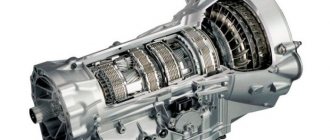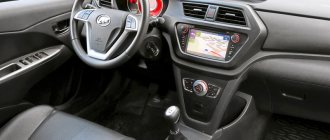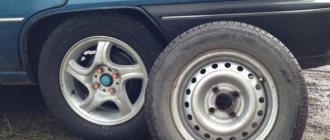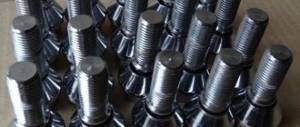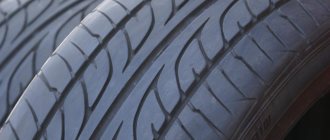Discs
Author temass
Date
Jul 18, 2017
41,887
Share
Disc offset is one of the most important geometric characteristics, along with the diameter and number of bolted connections. Although there is still a slight discrepancy from the requirements that the company that manufactures and produces the car insists on.
- Minus or negative offset
- Large offset (15,35,40,45) and its increase using a spacer
- The influence of wheel width and offset ET on driving characteristics
- Acceptable table of deviations for the most common car brands (Mercedes, Toyota, UAZ)
To correctly measure the distance between the vertical (vertical) plane of symmetry of the wheel and the surface of the disk itself to the car hub in mm, you need to use the formula: ET=ab/2, where a is the span between two verticals, the inner plane, and the surface adjacent to the hub b – the entire width of the car rim. To put it in ordinary, understandable words, the offset of an ET disc is an indicator of how much it looks outward from the wheel arch. If the offset is large, then the wheel will retreat deeper, and if its indicator decreases, on the contrary, it will move outward.
WATCH THE VIDEO
Having looked at the formula and tried to calculate the offset on ET wheel rims, there is a possibility of seeing that its value can be:
- Null;
- Negative;
- Positive.
This value is often applied to the inner surface of any car rim, and their unit of measurement is expressed in mm. Other parameters of the disks are also included; they mean the following:
- Width;
- Diameter;
- PCD of the disk - the number of mounting bolts and the diameter of their location;
- DIA - diameter of the mounting hole located in the center;
- MAX LOAD - maximum load on the disk.
Departure marking rules
When marking a disc, its offset is indicated by the ET indicator, followed by the distance from the mounting plane to the center line in millimeters. For example, in the cipher 6.5J×15 H2 5/112 ET39 d57.1 you can see that the offset of this disk is 39 millimeters. Plus, from the abbreviation ET39 you can understand that we are dealing with a positive parameter. If this model had a negative or zero offset, then instead of ET39 we would see ET0 or ET-39.
With such a variety of options, a natural question arises for the car owner: “Well, which offset should I choose - minus, plus or zero?” A lot depends on the answer to this question, because the wrong ET will not allow you to physically attach the disk to the car. It will begin to cling to the shock absorber strut.
Who determines the dimensional parameters of the departure
On factory car wheels, the offset size is determined by the vehicle's designers. They select the wheel geometry for the expected load and speed conditions, and also take into account hidden nuances that affect the life of the wheel, tire and the car itself. Therefore, when replacing wheels, the car owner should listen to these recommendations, choosing cast, forged or stamped models with a geometry similar to the factory wheel.
By the way, manufacturers of cast, stamped or forged wheels do the same. They determine the parameters of their products precisely according to factory recommendations. Therefore, each manufacturer of car wheels not only indicates the compatibility of a specific model of its product with the car brand, but also provides the name of the certificate or standard confirming this compliance. After all, an attempt to put the wrong disc on a car will end in a guaranteed accident, for which both the car owner and the discs can be held responsible.
What does wheel offset affect?
The distance from the plane of attachment to the hub to the center line of the disk depends on its width. If the manufacturer increases the width, he has to reduce the ET by moving the wheel towards the wing. Otherwise it will start to cling to the suspension. By the way, this fact is associated with a funny misconception among novice drivers who believe that the higher the ET value, the further the wheel will stick out beyond the car body. In reality, everything is completely different - the lower the ET, the higher the chances that the wheel will cling to the body fender, especially when the suspension sag.
Too much offset leads to unwanted contact of the wheel with the shock absorber struts and suspension elements, and too little ET value will cause friction on the wing. In addition, with prohibitively high ET values, the wheel will stick into the brake caliper, and reducing the offset too much will overload the hub bearings.
The model of distribution of force vectors in the suspension also deserves special attention. The point of application of these forces can be called the contact patch of the tire with the road, and the center line (vertical axis) of the wheel should pass through its center. It will correspond to the gravity vectors. The force vector from the suspension strut will also fall into approximately the same area.
With non-standard ET values, the center line and extension of the suspension axis will extend beyond the contact patch, causing overload, leading to rapid wear of the hub, bearing, lever and steering joint. This problem can be solved by strengthening these parts, but this will affect the cost of the car. In addition, when the force vectors go beyond the boundaries of the contact patch, the car's handling will deteriorate - the driver will have to apply more force to turn the steering wheel. Therefore, you should not go beyond the permissible offset deviations under any circumstances. In any case, try to follow the recommendations of the car manufacturer.
ET on disks - what does it mean and how is it calculated
The designation in the form of two letters of the Latin alphabet ET is not accidental, since this value is international and is determined by the following formula and is expressed in mm, regardless of the country of the disk manufacturer:
You might be interested in this: About the wheel bolt pattern on domestic VAZ cars
ET = X – Y/2,
Where X is the distance from the outer mating plane of the disk to its inner edge on the side of attachment to the hub or the size that is determined by measuring from the side edge of the wheel along the sides to its grille.
Y is the overall width of the product along the rim.
Important!
As a marking, wheel manufacturers, as a rule, prescribe this value as ET20, ET35, ET42, etc., and any professional can always read it and define these values.
Disc with negative offset
How to measure the overhang with your own hands - step-by-step instructions
Recommendations from the car manufacturer and certificates from the wheel company are the most reliable source from which you can determine the correct wheel parameters. But what should you do if these sources are not available, for example, when you are trying to buy a wheel for a car of a very old brand? In this case, we recommend that you measure the wheel offset yourself.
To do this, you will need the wheel itself, removed from the car, a perfectly level bar (it can be replaced with a building level) and a tape measure. And the measurement process itself will look like this:
- Place the wheel face down on a flat surface.
- Place a building level on the wheel rim.
- Next, you need to measure the distance from the mating plane to the bottom edge of the level.
- We record this distance. It can be designated as "A".
- Turn the wheel over (back side down).
- Place a level on the rim.
- At this stage, you need to measure the distance from the mating surface by running a tape measure into the hole under the hub.
- We record the second measurement as distance “B”.
- To determine the wheel offset we use the formula: ET = (A+B)/2 – B.
- We substitute the obtained values of A and B into the formula and carry out calculations taking into account the signs.
Using this technology, you can deal with ET offset on alloy wheels and forged models, as well as on stamped wheels. You just have to remove the tire before taking measurements. Rubber protruding beyond the wheel flanges will reduce the measurement accuracy.
How to determine the permissible ET deviation for a disk
As a rule, each automaker dictates its own permissible deviations for disc offset, and they depend only on the design of the frame, suspension, calipers, wheel arches and other elements of the vehicle. This means that for each car caliper there is a certain indicator of compatibility of various sizes, expressed in the range from minimum to maximum ET in millimeters. So, below are the permissible deviation indicators for the 35 most popular car models in Russia:
| Item no. | Car model and modification | Overhang ranges, ET, mm |
| 1 | Audi A4 | 35 |
| 2 | Audi A6 | 35 |
| 3 | Audi Q7 | 53 |
| 4 | BMW 3 | 15-25 |
| 5 | BMW 5 | 18-20 |
| 6 | BMW X5 | 40-45 |
| 7 | Citroen Evasion | 28-30 |
| 8 | Citroen Xantia | 15-22 |
| 9 | Daewoo Nexia | 38-42 |
| 10 | Daewoo Matiz | 38 |
| 11 | Dodge Caliber | 35-40 |
| 12 | Fiat Bravo | 31-32 |
| 13 | Ford Focus | 35-38 |
| 14 | Ford Mondeo | 35-42 |
| 15 | Ford Explorer | 0-3 |
| 16 | Honda Civic | 35-38 |
| 17 | Honda Jazz | 35-38 |
| 18 | Honda CRV | 40-45 |
| 19 | Hyundai Accent | 35-38 |
| 20 | Hyundai Sonata | 35-38 |
| 21 | Kia Ceed | 38-42 |
| 22 | Kia Sportage | 0-3 |
| 23 | MercedesBenz A-Class | 45-50 |
| 24 | MercedesBenz E-Class | 48-54 |
| 25 | MercedesBenz ML-Class | 46-60 |
| 26 | Mitsubishi Lancer | 35-42 |
| 27 | Mitsubishi Pajero | -25 to -15 |
| 28 | Nissan Almera | 35-42 |
| 29 | Nissan Maxima | 35-42 |
| 30 | Nissan Patrol | -25 to -15 |
| 31 | Toyota Corolla | 35-38 |
| 32 | Toyota Camry | 35-38 |
| 33 | Toyota Land Cruiser 200 | from -15 to 3 |
| 34 | Volkswagen Golf | 35-40 |
| 35 | Volkswagen Tiguan | 20-32 |
As for Russian VAZs, these cars are universal with the exception of the iconic Niva. Thus, the ET dimension for these car models is mainly 35-38 mm, which also corresponds to many indicators of the world's leading automakers.
You might be interested in: About painting car rims and painting equipment
Measurable indicators for calculating departure
From this table it can be seen that negative offset is a familiar parameter only for full-size SUVs, and the smaller it is, the more the wheels stick out on them, however, this gives them additional stability on very difficult sections of bad roads; plastic linings around the perimeter of the wheel arches are often as standard. In addition, these brands of cars have a reinforced suspension, a bolt pattern of at least 5x115, which is better than on passenger cars and absorbs bending moment.
Popular tire models
- Yandex.Market rating: Yandex.Market: 4.5
Goodyear UltraGrip Ice Arctic TiresSeasonality: winter Spikes: yes Diameter: 14 / 15 / 16 / 17 / 18 / 19
- Yandex.Market rating: Yandex.Market: 4.5
Goodyear Eagle Sport Tires
Seasonality: summer Spikes: no Diameter: 14 / 15 / 16
- Yandex.Market rating: Yandex.Market: 4.5
Goodyear EfficientGrip Performance Tires
Seasonality: summer Spikes: no Diameter: 15 / 16 / 17 / 18 / 19 / 20
- Yandex.Market rating: Yandex.Market: 4.5
Goodyear UltraGrip Ice 2 tires
Seasonality: winter Spikes: no Diameter: 14 / 15 / 16 / 17 / 18 / 19
- Yandex.Market rating: Yandex.Market: 4.5
Goodyear Eagle Sport TZ tires
Seasonality: summer Spikes: no Diameter: 16 / 17 / 18
- Goodyear Eagle Sport SUV TZ tires
Seasonality: summer Spikes: no Diameter: 17 / 18
- Tires Goodyear Eagle F1 Asymmetric 5
Seasonality: summer Spikes: no Diameter: 17 / 18 / 19 / 20 / 21 / 22
- Yandex.Market rating: Yandex.Market: 4.5
Goodyear UltraGrip Ice Arctic SUV Tires
Seasonality: winter Spikes: yes Diameter: 15 / 16 / 17 / 18 / 19 / 20
- Yandex.Market rating: Yandex.Market: 4.5
Goodyear Wrangler All-Terrain Adventure tires with Kevlar
Seasonality: summer Spikes: no Diameter: 15 / 16 / 17 / 18 / 19 / 20
- Yandex.Market rating: Yandex.Market: 5
Goodyear UltraGrip Ice SUV Tires
Seasonality: winter Spikes: no Diameter: 16 / 17 / 18 / 19 / 20
- Yandex.Market rating: Yandex.Market: 4.5
Goodyear EfficientGrip SUV Tires
Seasonality: summer Spikes: no Diameter: 17 / 18 / 19 / 20 / 21 / 22
- Goodyear Wrangler HP All Weather Tires
Seasonality: summer Spikes: no Diameter: 15 / 16 / 17 / 18 / 19
- Yandex.Market rating: Yandex.Market: 4.5
Goodyear UltraGrip Performance SUV Gen-1 Tires
Seasonality: winter Spikes: no Diameter: 16 / 17 / 18 / 19 / 20 / 21
- Goodyear Eagle F1 SuperSport Tires
Seasonality: summer Spikes: no Diameter: 18 / 19 / 20 / 21
- Goodyear Eagle F1 Asymmetric 3 SUV tires
Seasonality: summer Spikes: no Diameter: 17 / 18 / 19 / 20 / 21 / 22
- Goodyear Eagle F1 SuperSport R tires
Seasonality: summer Spikes: no Diameter: 18 / 19 / 20 / 21
- Goodyear Eagle F1 SuperSport RS Tires
Seasonality: summer Spikes: no Diameter: 21
Acceptable table of deviations for the most common car brands (Mercedes, Toyota, UAZ)
Each specific car brand has its own permissible deviations, which are best not violated.
| No. | Automobile model | Allowable disc overhang, mm |
| 1 | Chevrolet Camaro | 38-50 |
| 2 | Chevrolet Corvette | 38-50 |
| 3 | Chevrolet Aveo 1.6 | 39 |
| 4 | Alfa Romeo 33 | 30-38 |
| 5 | Alfa Romeo GTV | 28 |
| 6 | Alfa Romeo 145 | 38 |
| 7 | Alfa Romeo 146 | 38 |
| 8 | Alfa Romeo 166 | 35-40 |
| 9 | Alfa Romeo 155 | 38 |
| 10 | Alfa Romeo 156 | 28-30 |
| 11 | Audi A4 | 35 |
| 12 | Audi A8 | 35 |
| 13 | Audi A6 | 35 |
| 14 | Audi 80 | 35-42 |
| 15 | Audi 100 | 35-42 |
| 16 | Audi TT | 28-30 |
| 17 | Audi Quattro | 35-42 |
| 18 | Audi A3 | 30-40 |
| 19 | BMW 3 | 15-25 |
| 20 | BMW 3 (E36) | 35-42 |
| 21 | BMW M3 | 18-20 |
| 22 | BMW 5 | 18-20 |
| 23 | BMW 7 | 18-20 |
| 24 | BMW 7 (E32) | 18-20 |
| 25 | BMW 8 | 18-20 |
| 26 | Citroen Berlingo | 15-22 |
| 27 | Citroen Jumper | 35 |
| 28 | Citroen Evasion | 28 – 30 |
| 29 | Citroen Xsara | 15 – 22 |
| 30 | Citroen Xantia | 15 – 22 |
| 31 | Daewoo Nexia | 38 – 42 |
| 32 | Daewoo Espero | 38 – 42 |
| 33 | Daewoo Lanos | 38 – 42 |
| 34 | Daewoo Matiz | 38 |
| 35 | Daewoo Leganza | 35 – 42 |
| 36 | Daewoo Nubira | 38 – 42 |
| 37 | Dodge Magnum 2.7 V6 | 24 |
| 38 | Dodge Avenger 2.0i | 35 – 39 |
| 39 | Dodge Caliber 2.0 | 35 |
| 40 | Dodge Caliber SRT4 2.4i | 40 |
| 41 | Dodge Caravan 2.4i | 35 – 40 |
| 42 | Dodge Challenger 6.1 V8 | 40 |
| 43 | Dodge Durango 3.7 V6 | 15 |
| 44 | Fiat Qubo 1.3 | 40-44 |
| 45 | Fiat Bravo 1.4i | 31 – 32 |
| 46 | Fiat Croma 2.2 | 35 – 41 |
| 47 | Fiat Doblo 1.9JTD 263 | 32 |
| 48 | Fiat Doblo 1.9JTD 223 | 32 |
| 49 | Ford Scorpio | 35 – 38 |
| 50 | Ford Cougar | 35 – 38 |
| 51 | Ford Explorer | 0 – 3 |
| 52 | Ford Escort | 35 – 38 |
| 53 | Ford Focus | 35 – 38 |
| 54 | Ford Focus 2 | 35 – 38 |
| 55 | Ford Fiesta | 35 – 38 |
| 56 | Ford Granada | 35 – 38 |
| 57 | Ford Galaxy | 42 – 45 |
| 58 | Ford Ka | 35 – 38 |
| 59 | Ford Mondeo 1 | 35 – 42 |
| 60 | Ford Mondeo 2 | 35 – 42 |
| 61 | Ford Mustang | 35 – 38 |
| 62 | Ford Sierra | 35 – 38 |
| 63 | Ford Scorpio | 35 – 38 |
| 64 | Ford Orion | 35 – 38 |
| 65 | Ford Puma | 35 – 38 |
| 66 | Ford Windstar | 35 – 38 |
| 67 | Ford Transit | 35 – 38 |
| 68 | Honda Shuttle | 35 – 38 |
| 69 | Honda CRX | 35 – 38 |
| 70 | Honda Accord | 35 – 38 |
| 71 | Honda Integra | 35 – 38 |
| 72 | Honda Civic | 35 – 38 |
| 73 | Honda Civic VTEC | 38 |
| 74 | Honda Concerto | 35 – 38 |
| 75 | Honda Jazz | 35 – 38 |
| 76 | Honda Prelude | 38 |
| 77 | Honda Legend | 35 – 38 |
| 78 | Honda CRV 5 | 40 – 45 |
| 79 | Hyundai Pony | 35 – 38 |
| 80 | Hyundai Accent | 35 – 38 |
| 81 | Hyundai Coupe | 35 – 38 |
| 82 | Hyundai Lantra | 35 – 38 |
| 83 | Hyundai Sonata | 35 – 38 |
| 84 | Hyundai Excel | 35 – 38 |
| 85 | Kia Shuma | 35 – 38 |
| 86 | Kia Ceed | 38 – 42 |
| 87 | Kia Leo | 35 – 38 |
| 88 | Kia Clarus | 35 – 38 |
| 89 | Kia Sephia | 35 – 38 |
| 90 | Kia Concord | 35 – 38 |
| 91 | Kia Sportage | 0 – 3 |
| 92 | Kia Mentor | 35 – 38 |
| 93 | Mercedes-Benz Sprinter | 45 |
| 94 | MercedesBenz A Class | 45 – 50 |
| 95 | MercedesBenz B-Class | 47 – 52 |
| 96 | MercedesBenz C-Class | 43 – 47 |
| 97 | MercedesBenz E-Class | 48 – 54 |
| 98 | MercedesBenz G-Class | 43, 50, 63 |
| 99 | MercedesBenz M-Class | 46 – 50, 60 |
| 100 | MercedesBenz S-Class | 36 – 43,5 |
| 101 | MercedesBenz SLK | 45 – 50 |
| 102 | MercedesBenz 600SL | 18 – 25 |
| 103 | MercedesBenz 280SL | 18 – 25 |
| 104 | MercedesBenz Vito | 45 – 50 |
| 105 | Mitsubishi Lancer | 35 – 42 |
WATCH THE VIDEO
It is recommended to compare the permissible disc offset deviations according to the table with those available on the driver’s car, and if they exceed the norms, then it is better to replace them.
An alternative option for measuring reach yourself
The Einpress Tief (indentation depth) of the wheel can be calculated using another method. To do this you will need the same level and ruler. Moreover, before starting the calculation, you need to do the following:
- Place the wheel face down on a flat surface.
- Place a level on the outside.
- Using a ruler, measure the distance from the supporting surface to the bottom edge of the level (from the front to the back side). This value can be designated as “B”.
- Measure the distance from the supporting surface to the plane that is in contact with the vehicle's hub. This value should be designated as “A”.
After this, we can use the formula ET=A-B/2, substituting the measured values into it. Moreover, the results of our calculations can be: zero, positive and negative. In the first case, the center line and the mating plane coincide down to a millimeter. In other cases, the attachment plane is above or below the midline.
How to correctly measure the offset of an ET disc
What is ET on disks and how to measure it correctly if circumstances are such that there is simply no other way to determine this indicator? Quite often, worn or damaged wheel rims make it impossible to correctly read the markings on their surface, and in this case, vehicle owners have to resort to their measurements.
To select the right wheel rim to replace a product that has expired, you need to determine the ET value on the old wheel by following these steps:
- If the disk is installed on a car, it must be removed using a wheel wrench or a special spanner tool for removing the wheel locks, if any were used when mounting the wheel on the hub. Before dismantling, it is necessary to raise the car with a jack so that the wheel can rotate freely in a hanging position.
- It is necessary to measure the back indentation on the disk, and to do this you must first carefully place the disk on a flat surface with the outer side down.
- The side of the disk that is attached to the hub is on top, and you need to put a wooden measuring rod on it, the length corresponding to the diameter of the wheel. Accordingly, the entire tool must be located on the steel sides of the wheel, and not on the rubber, otherwise the offset will be determined incorrectly, which will lead to errors when purchasing a wheel.
- Using a tape measure or ruler, measure the distance from the mating plane of the disk to the edge of the wooden product. The result is recorded in millimeters.
- The procedure must be repeated, turning the disk upside down, and as a result, the car owner will have 2 indicators recorded - front and rear overhang, which add up to the overall ET indicator through simple calculations.
You can also measure the overall width of the rim to get the value using the formula ET = X – Y/2.
With the described measurement, the formula ET = (A + B)/2 – B is available to the car enthusiast, where A is the first measurement - the amount of indentation from the rear side, B is the same indicator, but from the front.
You may be interested in: Selecting wheels by car model
Measuring the jack of the disc
What to do if the departure does not correspond to the basic value
If a car wheel “flies” beyond the permissible values by 10 millimeters, you should not buy such a wheel, no matter what its owners or sales consultants tell you. A deviation of ±5 millimeters is a completely different matter. Most automakers allow such a variation, especially if the outer diameter of the tire remains “within” the standard values.
If the automaker does not recommend even a 5mm deviation, and the disc is sold at an attractively low price, you can solve the incompatibility problem using special spacer inserts. They are also used if the car owner does not want to risk the suspension and hub, hoping for an acceptable spread in the offset values.
Wheel spacers - what are they and how to use them
A spacer is a washer that is inserted between the hub and the mating plane. She corrects the wrong departure. In addition, it can be used to extend the wheelbase and eliminate misalignment of bolt holes. Moreover, there are spacers:
- Thin - from 3 to 20 mm according to the height of the washer. Using this insert, you can move the cast or forged wheel away from the hub, eliminating friction between the tire and the suspension.
- Thick - from 20 to 30 mm in depth. Using this washer, you can select a negative offset by moving the wheel away from the car fender.
- Extra thick - from 30 to 40 mm. Such spacers are used by tuning masters who fit cast and forged wheels to the arches of jeeps. Extra thick spacers are not suitable for ordinary passenger cars.
An experienced tire mechanic can use a spacer to correct incorrect offset, ensuring a long life for the hub, bearings and suspension. In addition, these inserts are used to expand the wheelbase. In this case, special models with a centering hole are used. However, even a perfectly selected spacer is just a “crutch” that eliminates the miscalculations of the buyer of the wrong discs only for a while. Deciding to trust your life to a thin metal washer is not a good idea. It's better to buy the right disc the first time.
Disc ejection: what is it?
Disc offset, or ET indicator, is a dimensional parameter that is indicated on the rim of the product, regardless of its radius or material of manufacture (stamped, cast or forged), and indicates the distance from the mating plane of the wheel to the attachment point to the hub. This dimension is usually set by the car manufacturer.
ET offset on wheels: what is it and how does it affect the suspension and other parts in the car? Depending on the wheel offset, the load on the hub and the bending moment applied relative to it at the base of the suspension are distributed differently. Thus, each automobile concern dictates the strength limit for its parts, which determines the range of wheel offsets.
Some cars, especially when it comes to SUVs and sports cars, are equipped with additional plastic mud flaps, which determine the wheel offset, which in such cases can be zero or even negative, which gives the “iron horse” a very impressive look.
ET departure using 3 indicators as an example

